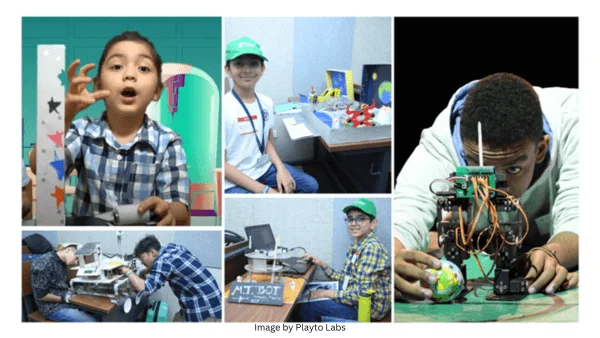In this highly evolving world of education, innovative methods are constantly being researched and implemented to engage and motivate students. Edutainment is one approach that mixes education and entertainment to create a dynamic and engaging learning experience that has been gaining popularity. To make learning more engaging, immersive, and successful, edutainment uses the power of technology, gamification, and interactive media.
The term “Edutainment” was coined by an American illustrator, Peter Catalanotto, in the 1990s while teaching students about writing and illustration. Combining education and entertainment became widespread in the United States after John Dewey, a philosopher and educator, encouraged experimental, engaging teaching methods to promote student excitement in learning.
What is Edutainment?
“Edutainment” is a blend of two words: Education and Entertainment. It describes the blending of educational and entertaining components to promote learning, with the understanding that successful learning can only occur when students are thoroughly engaged and motivated. Edutainment blurs the conventional lines between education and entertainment. It makes traditional education more engaging and immersive by adding gaming mechanics, simulations, storytelling, virtual reality, augmented reality and multimedia.
Edutainment: Making Learning Fun
Traditional games such as jigsaw puzzles, chess and miming games improve learning abilities by developing dexterity, spatial relationships, logical thinking, creativity and teamwork. While Chess helps increase their reading comprehension, memorisation, arithmetic skills, and creative thinking abilities, miming games help improve creativity, teamwork and writing skills as the game involves students competing as teams, writing words on paper, and guessing the correct answer.
Nowadays, technologies like virtual reality (VR) and augmented reality (AR) have opened up new possibilities in education. Teachers use tech-enabled board games and toys, AR-VR-based games and simulations, interactive museums, books, films, and other media to teach specific themes or concepts and engage the learners.
One of the noteworthy educational platforms that keeps edutainment at the core is Playto Labs. The platform focuses on hands-on experience for building robots and supporting children in developing an interest in science, technology, and coding (STEM).
Playto Labs provides 1:1 live online robotics classes for kids breaking the usual mold. Each enrolled student utilises a Playto Robotics Kit in a 1:1 live class to build various projects, create different types of robots, and engage in a fun and interactive learning process. This enhances problem-solving and critical thinking skills, fostering a more creative mindset and eventually making learning fun.

Edutainment has uses outside of the classroom as well. Edutainment is used by several groups in countries like the United States, the United Kingdom, and Africa to educate people about social concerns such as drug misuse, immunisation, and teen pregnancy.
There are various mobile applications and educational games as well that have transformed the way children and adults learn. From language learning apps to math puzzles and science simulations, these tools provide an interactive and enjoyable learning experience.
Tappity is another popular kids’ science app that offers over 200 science topics through fun experiments, stories, and games. It aligns with the Next Generation Science Standards for K-5th Grade, making it an excellent choice for children interested in science and their schoolwork.
Here is a video to better understand “Edutainment”: Transforming Education Through Edutainment by Roland Nunez (TED Talk)
Why Choose Edutainment?
Including edutainment in the classroom has several advantages for both teachers and students. Edutainment helps create a dynamic learning environment that captures students’ attention and encourages active involvement in the school. It presents cutting-edge and engaging methods of instruction that include multimedia, gamification, AR-VR simulations, and other technological components. Student motivation and engagement are increased by educational entertainment, which also helps students remember and comprehend complex concepts. With edutainment, teachers may turn traditional classrooms into engaging learning environments that prepare students for the challenges of the digital age by adopting edutainment.
The following are the key reasons you should consider picking edutainment:
Increased Engagement
The engaging and interactive nature of edutainment captivates students. Combining educational materials with entertaining elements inspires students to participate in learning. Also, using gamification tactics like points, awards, and leaderboards that promote healthy competition and a sense of accomplishment helps enhance student engagement and motivation.
Improved Retention and Understanding
Learning retention and understanding of complex topics are improved when students are entertained. Edutainment uses narrative, imagery, and interactive elements to produce memorable learning experiences. Edutainment aids students in gaining a more profound knowledge of the material by presenting it entertainingly and engagingly.
Personalised Learning
Edutainment frequently uses personalised and adaptive learning technologies, which change the content and difficulty level based on each student’s needs. This individualised method ensures that students receive content appropriate for their proficiency level to enhance learning outcomes.
Collaboration and Social Interaction
Many edutainment platforms include collaborative elements that enable students to communicate with one another and cooperate to solve problems in the classroom. Encouraging teamwork and communication skills promotes a sense of community and cooperation.
Challenges of Edutainment
While edutainment holds immense potential, it also faces a few challenges that must be addressed.
Let us have a look at some of its challenges:
Content Quality
One of the primary challenges in edutainment is maintaining the quality of educational content. Striking a balance between entertainment value and educational substance takes time and effort. Educators must ensure that the educational material integrated into entertainment platforms is accurate, reliable, and aligned with the intended learning objectives.
Learning Effectiveness
While edutainment aims to make learning enjoyable, it must also effectively promote learning outcomes. Assessing and measuring the impact of edutainment on knowledge acquisition, critical thinking skills, and long-term retention can be complex. Evaluating the educational effectiveness of edutainment initiatives is crucial for their success.
Individual Differences
Often, Educators face challenges in creating educational content that caters to learners’ diverse learning requirements, interests, and preferences. Personalisation and modification may be necessary to ensure meaningful participation and benefit from the educational elements integrated into the entertainment format.
Limitations of Technology
While edutainment frequently uses technology to deliver interactive and immersive experiences, the widespread adoption and efficacy of such projects may face challenges due to technological barriers. Issues such as limited access to gadgets, internet connectivity, and technical problems, particularly in environments with limited resources, can hinder the full realisation of edutainment’s potential.
Curriculum Alignment
Adding edutainment to already-existing curriculums requires careful planning and collaboration with educators. It takes careful preparation and collaboration with educational stakeholders to align the educational content and learning objectives of edutainment efforts with formal educational frameworks. A big problem can be ensuring that edutainment adheres to academic standards and enhances the overall curriculum.
Despite various difficulties, edutainment is revolutionising education—a very effective and entertaining learning method.
By combining engaging and interactive elements into educational content, edutainment offers students a memorable and enjoyable learning experience while challenging conventional teaching strategies. Traditional classrooms might be redesigned, making learning flexible enough to accommodate different learning preferences. Edutainment is emerging as a crucial element in the educational environment, altering how we approach teaching and learning.
In the coming years, we can expect more innovative solutions seamlessly integrating education and entertainment. Also, the rise of artificial intelligence, immersive simulations, and personalised learning will further enhance the edutainment experience, making education more accessible, engaging, and impactful. The future of edutainment seems highly promising.


